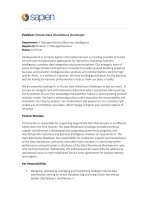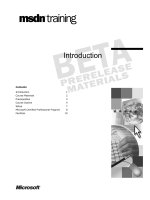Tài liệu Controlling Sound with ActionScript pdf
Bạn đang xem bản rút gọn của tài liệu. Xem và tải ngay bản đầy đủ của tài liệu tại đây (30.84 KB, 1 trang )
< Day Day Up >
Controlling Sound with ActionScript
Although most of us can enjoy listening to music without thinking too much about what
we're hearing, the vibrations that make up even the most elementary sounds are actually
far from simple—a fact made evident by the processing-power requirements of most
audio-editing programs. Despite the complexity of even the simplest audio clip, however,
sounds can be broken down into three basic characteristics:
•
Length. A sound's length can provide sensory cues about size (the short chirp of a
small-car horn compared to the roar of a semi-truck's horn) and urgency (the tinkle
of a viciously shaken dinner bell compared to the long bong of a lazy Sunday
church bell).
•
Volume. A sound's volume provides clues about distance. Louder sounds give the
feeling of closeness, whereas quiet sounds imply distance. A sound that gradually
goes from quiet to loud or vice versa creates a sense of movement.
•
Panning. Panning represents the position of the sound from left to right or right to
left. Like volume, panning allows you to determine the relative position of the
element making the sound. If you were to close your eyes at a tennis match, you
could accurately determine the position of the ball (left or right of the net) simply
by the "pop" of the ball being smacked by the racket.
With Flash, you can control sound characteristics simply by editing sound instances on
the timeline—a solution that works well for presentations that don't require audience or
user participation. However, if you want to give your user control—allowing the user to
move and slide things around—you need a more dynamic solution. Fortunately, you can
easily emulate and control all of these sound characteristics via ActionScript.
< Day Day Up >









